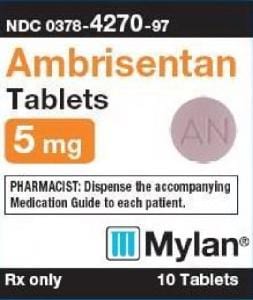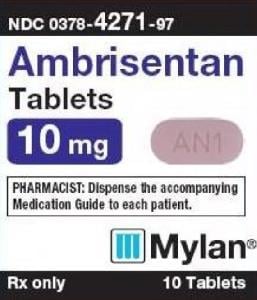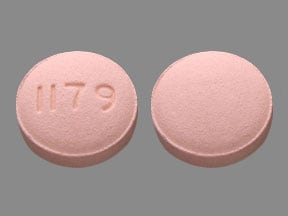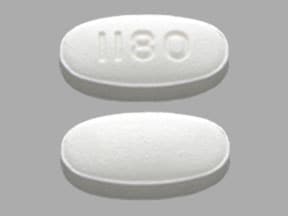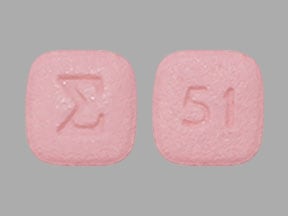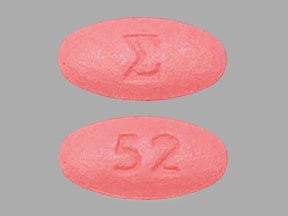Boxed Warning
Embryo-fetal toxicity:
Do not administer ambrisentan to a pregnant female because it may cause fetal harm. Ambrisentan is very likely to produce serious birth defects if used by pregnant females as this effect has been seen consistently when it is administered to animals.
Exclude pregnancy before the initiation of treatment with ambrisentan. Females of reproductive potential must use acceptable methods of contraception during treatment with ambrisentan and for 1 month after treatment. Obtain monthly pregnancy tests during treatment and 1 month after discontinuation of treatment.
Because of the risk of embryo-fetal toxicity, for all female patients, ambrisentan is only available through a restricted program under a Risk Evaluation and Mitigation Strategy (REMS) called the Ambrisentan REMS program.
Dosage Forms
Excipient information presented when available (limited, particularly for generics); consult specific product labeling.
Tablet, Oral:
Letairis: 5 mg, 10 mg [contains fd&c red #40 aluminum lake]
Generic: 5 mg, 10 mg
Pharmacology
Mechanism of Action
Blocks endothelin receptor subtypes ETA and ETB on vascular endothelium and smooth muscle. Stimulation of ETA receptors, located primarily in pulmonary vascular smooth muscle cells is associated with vasoconstriction and cellular proliferation. Stimulation of ETB receptors, located in both pulmonary vascular endothelial cells and smooth muscle cells is associated with vasodilation, antiproliferative effects, and endothelin clearance. Although ambrisentan blocks both ETA and ETB receptors, the affinity is greater for the ETA receptor (>4,000-fold higher affinity).
Pharmacokinetics/Pharmacodynamics
Metabolism
Hepatic via CYP3A4, CYP2C19, and uridine 5'-diphosphate glucuronosyltransferases (UGTs) 1A9S, 2B7S, and 1A3S; in vitro studies also suggest it is a substrate of organic anion transporting polypeptides (OATP) 1B1 and 1B3 and P-glycoprotein (P-gp)
Excretion
Primarily nonrenal
Time to Peak
~2 hours
Half-Life Elimination
~9 hours
Protein Binding
99%
Use: Labeled Indications
Pulmonary arterial hypertension: Treatment of pulmonary artery hypertension (PAH) (World Health Organization [WHO] Group I) to improve exercise ability and delay clinical worsening; in combination with tadalafil to reduce the risks of disease progression and hospitalization for worsening PAH, and to improve exercise ability. Studies establishing effectiveness included predominantly patients with WHO Functional Class II to III symptoms and etiologies of idiopathic or heritable PAH (60%) or PAH associated with connective tissue diseases (34%).
Note: According to treatment guidelines from the Fifth World Symposium on Pulmonary Hypertension (WSPH), only a small number of PAH patients with WHO-FC IV symptoms (ie, severely ill patients) were included in clinical trials, therefore, most experts consider ambrisentan second-line therapy in these patients (WSPH [Gailè 2013]).
Contraindications
Pregnancy; idiopathic pulmonary fibrosis, including idiopathic pulmonary fibrosis with pulmonary hypertension (WHO Group 3)
Canadian labeling: Additional contraindications (not in US labeling): Hypersensitivity to ambrisentan or any component of the formulation; severe hepatic impairment (with or without cirrhosis); ALT or AST >3 times ULN at baseline; breastfeeding
Dosage and Administration
Dosing: Adult
Pulmonary arterial hypertension: Oral: Initial: 5 mg once daily, with or without tadalafil; at 4-week intervals, as tolerated and necessary, may increase either the dose of ambrisentan (maximum dose: 10 mg/day) or tadalafil (if used concomitantly).
Dosage adjustment for concomitant therapy: Coadministration with cyclosporine: Ambrisentan dose should not exceed 5 mg/day
Dosing: Geriatric
Refer to adult dosing.
Administration
Oral: Swallow tablet whole. Do not split, crush, or chew tablets. Administer with or without food.
Storage
Store at 25°C (77°F); excursions are permitted between 15°C and 30°C (59°F and 86°F). Store in original packaging.
Ambrisentan Images
Drug Interactions
CycloSPORINE (Systemic): May increase the serum concentration of Ambrisentan. Management: Limit ambrisentan dose to 5 mg/day and monitor for ambrisentan adverse reactions in patients receiving systemic cyclosporine. Consider therapy modification
Adverse Reactions
Frequency not always defined.
Cardiovascular: Peripheral edema (14% to 38%), flushing (4%)
Central nervous system: Headache (34%)
Gastrointestinal: Dyspepsia (3%)
Genitourinary: Oligospermia
Hematologic & oncologic: Decreased hemoglobin (7% to 10%; dose-dependent), anemia (7%), decreased hematocrit
Respiratory: Nasal congestion (6% to 16%), cough (13%), bronchitis (4%), sinusitis (3%)
<1%, postmarketing, and/or case reports: Cardiac failure, dizziness, fatigue, fluid retention, hypersensitivity, hypotension, increased liver enzymes, nausea, vomiting, weakness
Warnings/Precautions
Concerns related to adverse effects:
- Fluid retention/peripheral edema: Development of peripheral edema due to treatment and/or disease state (pulmonary arterial hypertension) may occur; a higher incidence is seen with concomitant use of tadalafil and in elderly patients. There have also been postmarketing reports of fluid retention requiring treatment (eg, diuretics, fluid management, hospitalization). Further evaluation may be necessary to determine cause and appropriate treatment or discontinuation of therapy.
- Hematologic changes: A reduction in hematocrit/hemoglobin may be observed within the first few weeks of therapy with subsequent stabilization of levels. Hemoglobin reductions >15% have been observed in some patients. Measure hemoglobin prior to initiating therapy, at 1 month, and periodically thereafter. Significant decreases in hemoglobin in the absence of other causes may warrant the discontinuation of therapy. Use not recommended in patients with clinically significant anemia.
- Hepatic effects: Increases in serum liver aminotransferases have been reported during postmarketing use; however, in the majority of the cases, alternative causes of hepatotoxicity could be identified. Perform liver enzyme testing when clinically indicated. Discontinue therapy if signs/symptoms of hepatic injury appear, if serum liver aminotransferases >5 times ULN (US labeling) or >3 times ULN (Canadian labeling) are observed, or if aminotransferases are increased in the presence of bilirubin >2 times ULN. Hepatotoxicity has been reported with other endothelin receptor antagonists (eg, bosentan); however, ambrisentan may be tried in patients that have experienced asymptomatic increases in liver enzymes caused by another endothelin receptor antagonist after the liver enzymes have returned to normal.
Disease-related concerns:
- Hepatic impairment: Use caution in patients with mild hepatic impairment; ambrisentan exposure may be increased. The US labeling does not recommend use in patients with moderate or severe impairment. The Canadian labeling recommends use with caution in moderate impairment with monthly monitoring of ALT/AST during therapy and contraindicates use in severe hepatic impairment (with or without cirrhosis) and in patients with ALT or AST >3 times ULN at baseline.
- Pulmonary veno-occlusive disease (PVOD): Discontinue in any patient with pulmonary edema suggestive of PVOD.
Special populations:
- Pregnancy: [US Boxed Warning]: Do not administer ambrisentan to a pregnant female because it may cause fetal harm. Ambrisentan is very likely to produce serious birth defects if used by pregnant females as this effect has been seen consistently when it is administered to animals. Exclude pregnancy before the initiation of treatment with ambrisentan. Females of reproductive potential must use acceptable methods of contraception during treatment with ambrisentan and for 1 month after treatment. Obtain monthly pregnancy tests during treatment and 1 month after discontinuation of treatment.
Concurrent drug therapy issues:
- Drug-drug interactions: Potentially significant interactions may exist, requiring dose or frequency adjustment, additional monitoring, and/or selection of alternative therapy. Consult drug interactions database for more detailed information.
Other warnings/precautions:
- REMS program: [US Boxed Warning]: Because of the risk of embryo-fetal toxicity, for all female patients, ambrisentan is only available through a restricted program under a REMS called the Ambrisentan REMS program. Female patients (regardless of reproductive potential), prescribers, and pharmacies that dispense ambrisentan must be registered with and meet conditions of the program. Call 1-888-417-3172 or visit https://www.ambrisentanrems.us.com for more information.
Monitoring Parameters
Monitor for significant peripheral edema and evaluate etiology if it occurs; hepatic enzyme testing when clinically appropriate. The Canadian labeling recommends hepatic function testing at baseline then as clinically indicated (all patients) and monthly during therapy (patients with moderate impairment or other risk factors [eg, significant right heart failure, preexisting hepatic disease or previously elevated transaminases, concurrent medications known to increase transaminases]).
Females of childbearing potential must have a negative pregnancy test prior to the initiation of therapy, monthly during treatment, and 1 month after stopping treatment. Hemoglobin and hematocrit should be measured at baseline, at 1 month, and periodically thereafter (generally stabilizes after the first few weeks of treatment).
Pregnancy
Pregnancy Considerations
Ambrisentan is contraindicated in pregnancy.
[US Boxed Warning]: Do not administer ambrisentan to a pregnant female because it may cause fetal harm. Ambrisentan is very likely to produce serious birth defects if used by pregnant females because this effect has been seen consistently when it is administered to animals.
Females with pulmonary arterial hypertension are encouraged to avoid pregnancy (McLaughlin 2009; Taichman 2014).
[US Boxed Warning]: Exclude pregnancy before the initiation of treatment with ambrisentan. Females of reproductive potential must have a negative pregnancy test prior to initiation of therapy. Females of reproductive potential must use acceptable methods of contraception during treatment and for 1 month after treatment. Obtain monthly pregnancy tests during treatment and 1 month after discontinuation of treatment. One highly effective form of contraception (intrauterine device, contraceptive implant, or tubal sterilization) or a combination of contraceptive methods (hormone contraceptive with a barrier method or 2 barrier methods) may be used. If the partner has had a vasectomy, a hormone or barrier method must also be used. A missed menses or suspected pregnancy should be reported to a health care provider and prompt immediate pregnancy testing. Sperm counts may be reduced in men during treatment (as observed with bosentan).
Patient Education
What is this drug used for?
- It is used to treat high blood pressure in the lungs.
Frequently reported side effects of this drug
- Headache
- Flushing
- Cough
- Runny nose
Other side effects of this drug: Talk with your doctor right away if you have any of these signs of:
- Liver problems like dark urine, fatigue, lack of appetite, nausea, abdominal pain, light-colored stools, vomiting, or yellow skin.
- Trouble breathing
- Swelling
- Weight gain
- Severe loss of strength and energy
- Signs of a significant reaction like wheezing; chest tightness; fever; itching; bad cough; blue skin color; seizures; or swelling of face, lips, tongue, or throat.
Note: This is not a comprehensive list of all side effects. Talk to your doctor if you have questions.
Consumer Information Use and Disclaimer: This information should not be used to decide whether or not to take this medicine or any other medicine. Only the healthcare provider has the knowledge and training to decide which medicines are right for a specific patient. This information does not endorse any medicine as safe, effective, or approved for treating any patient or health condition. This is only a brief summary of general information about this medicine. It does NOT include all information about the possible uses, directions, warnings, precautions, interactions, adverse effects, or risks that may apply to this medicine. This information is not specific medical advice and does not replace information you receive from the healthcare provider. You must talk with the healthcare provider for complete information about the risks and benefits of using this medicine.
